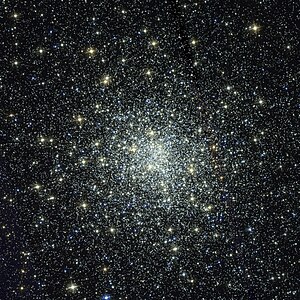| Messier 28 | |
|---|---|
 Globular cluster Messier 28 in Sagittarius | |
| Observation data (J2000 epoch) | |
| Class | IV[1] |
| Constellation | Sagittarius |
| Right ascension | 18h 24m 32.89s[2] |
| Declination | –24° 52′ 11.4″[2] |
| Distance | 18.26 ± 0.98 kly (5.6 ± 0.3 kpc)[3] |
| Apparent magnitude (V) | 6.8[4] |
| Apparent dimensions (V) | 11′.2[5] |
| Physical characteristics | |
| Mass | 5.51×105[6] M☉ |
| Radius | 30 ly[7] |
| VHB | 15.55 ± 0.10[8] |
| Metallicity | = –1.32[6] dex |
| Estimated age | 12.0 Gyr[9] |
| Notable features | Contains first pulsar discovered in a globular[10] |
| Other designations | GCl 94, M 28, NGC 6626[2] |
Messier 28 or M28, also known as NGC 6626, is a globular cluster of stars in the center-west of Sagittarius. It was discovered by French astronomer Charles Messier in 1764.[11][a] He briefly described it as a "nebula containing no star... round, seen with difficulty in 31⁄2-foot telescope; Diam 2′."[12]
In the sky it is less than a degree to the northwest of the 3rd magnitude star Kaus Borealis (Lambda Sgr). This cluster is faintly visible as a hazy patch with a pair of binoculars[11] and can be readily found in a small telescope with an 8 cm (3.1 in) aperture, showing as a nebulous feature spanning 11.2 arcminutes. Using an aperture of 15 cm (5.9 in), the core becomes visible and a few distinct stars can be resolved, along the periphery. Larger telescopes will provide greater resolution,[5] one of 25 cm (9.8 in) revealing a dense 2′ core, with more density within.[11]
It is about 18,300 light-years away from Earth.[3] It is about 551000 M☉[6] and its metallicity (averaging −1.32 which means more than 10 times less than our own star), coherency and preponderence of older stellar evolution objects, support its dating to very roughly 12 billion years old.[9] 18 RR Lyrae type variable stars have been found within.
It bore the first discovery of a millisecond pulsar in a globular cluster – PSR B1821–24. This was using the Lovell Telescope at Jodrell Bank Observatory, England.[10] A total of 11 further of these have since been detected in it with the telescope at Green Bank Observatory, West Virginia. As of 2011, these number the third-most in a cluster tied to the Milky Way, following Terzan 5 and 47 Tucanae.[13]
- ^ Cite error: The named reference
hcob849_11was invoked but never defined (see the help page). - ^ a b c "M 28". SIMBAD. Centre de données astronomiques de Strasbourg. Retrieved 2006-11-16.
- ^ a b Cite error: The named reference
Oliveirawas invoked but never defined (see the help page). - ^ "Messier 28". SEDS Messier Catalog. Retrieved 21 July 2024.
- ^ a b Cite error: The named reference
inglis2004was invoked but never defined (see the help page). - ^ a b c Cite error: The named reference
apj742_1_51was invoked but never defined (see the help page). - ^ From trigonometry: radius = distance × sin( diameter_angle / 2 ) = 30 ly
- ^ Cite error: The named reference
aj121_2_916was invoked but never defined (see the help page). - ^ a b Cite error: The named reference
mnras385_4_1998was invoked but never defined (see the help page). - ^ a b "JBO - Stars". Jodrell Bank Observatory. Retrieved 2007-06-01.
- ^ a b c Cite error: The named reference
thompson2007was invoked but never defined (see the help page). - ^ Cite error: The named reference
burnham1979was invoked but never defined (see the help page). - ^ Cite error: The named reference
apj730_2_81was invoked but never defined (see the help page).
Cite error: There are <ref group=lower-alpha> tags or {{efn}} templates on this page, but the references will not show without a {{reflist|group=lower-alpha}} template or {{notelist}} template (see the help page).
![{\displaystyle {\begin{smallmatrix}\left[{\ce {Fe}}/{\ce {H}}\right]\end{smallmatrix}}}](https://wikimedia.org/api/rest_v1/media/math/render/svg/4c0821bd80891e071c08e7c7ee8e022baedf522c)